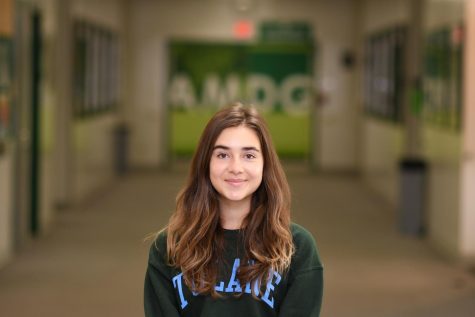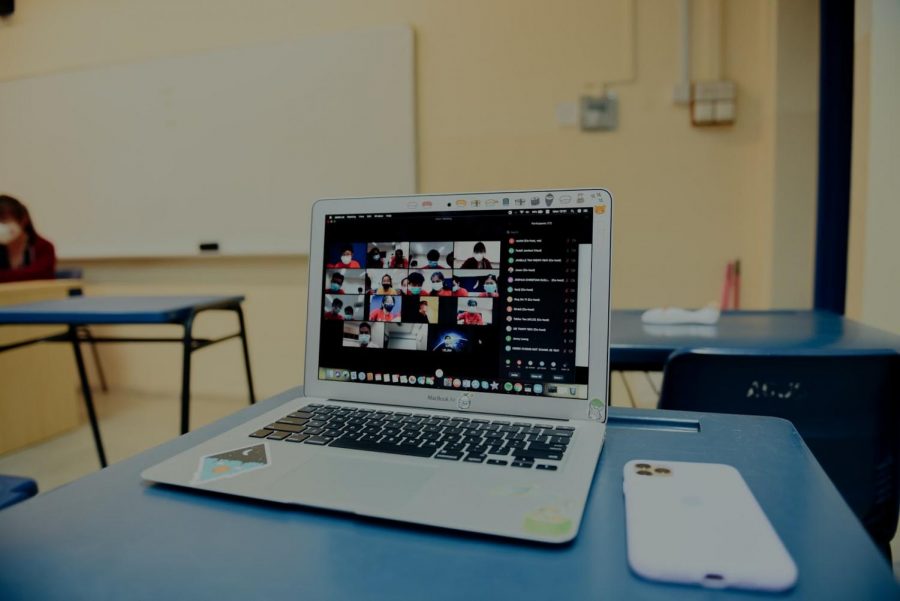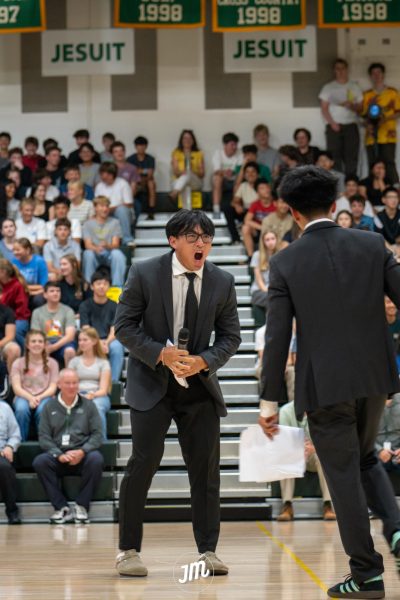Teaching with Zoom: How teachers are transitioning from Zoom calls at home to Zoom calls at School
A student in class with the hybrid-learning model would need to use some kind of computer or tablet.
On February 9, Jesuit High School reopened for hybrid-learning due to Governor Kate Brown’s continuance of the return-to-school directive. In the hybrid model, with half of the class learning from home over Zoom and the other half attending school in-person, teachers designed a curriculum that works for both environments.
In order to compensate both virtual and in-person students for the hybrid model, Jesuit purchased new and advanced technology. Alyssa Tormala, the vice principal of professional development and innovation at Jesuit, offers insight into how teachers are conducting Zoom calls in-person with the new technology.
“When a hybrid class is going and the teacher is in the classroom, they will have half of the class sitting in the classroom, and they will have half the class on Zoom,” Tormala said. “To help facilitate that, teachers will have two computers in the classroom. One will be the computer that is projecting and sharing materials for the class as usual, and the other one will be running the Zoom call, so the teacher can see and interact directly with the students at home. We also have webcams with high-quality microphones that are connected to Zoom and the classroom speaker system. Teachers can move the webcam around as needed.”
Theology teacher Zach Lantz has connected students from both environments by directing the webcam on the students present in the classroom and projecting the virtual students on the screen so that they can interact with one another.
The new technology enables the classroom experience to be more dynamic and inclusive, despite its inherent complexity.
Art teacher Danielle Chi, follows the Zoom procedure outlined by Ms. Tormala, but tailors it to the needs of her course.
“I have been teaching with the Zoom camera on me and the webcam on my classroom so students on zoom are seeing my students in the class, which is also being cast for the students in class to see the students on Zoom,” Chi said. “I will introduce the assignment for the day or the next project we are working on, and the students on Zoom can go off of Zoom and do their art, and the students in the classroom can work on their art in the classroom. At the end of every class period, students doing virtual learning or in-person learning, they all take a picture of their progress or their final artwork and upload it to canvas by the end of class, so I can see what they have worked on that day.”
To prepare for hybrid learning, teachers participated in a week-long training program during the asynchronous week. Ms. Tormala details the logistics.
“On Friday January 15, we had all faculty training on best practices for hybrid learning, such as how to build hybrid lessons and how to bridge between cohorts,” Tormala said. “Then, during each day of the week of January 19…we had two departments on campus…for in-person classroom training on equipment, classroom protocols and campus procedures. Faculty also had time during the week to practice with classroom equipment, ask questions, prepare lessons, and collaborate with colleagues. For the following weeks, we asked faculty to be on campus at least two days a week so they could transition to teaching in hybrid mode.”
“We had one full day where we came and experimented with tech, and they walked us through it,” Lantz said. “The [rest of the week], I taught from [Jesuit] with the tech. I feel like I am better at setting up a classroom, especially when nothing has been set up yet.”
When questioned about how the Jesuit administration decided on the Covid and Zoom procedures for the hybrid-model, Ms. Tormala emphasized that it took plenty of research and collaboration.
“Tons of research,” Tormala said. “We looked at the state guidelines and restrictions we have to have in place, which guided our decision for what a hybrid model could look like at JHS specifically. When we knew those parameters, then we were able to reach out to other schools, talk to experts, [and] learn what works and what doesn’t from those who have already been doing hybrid since last August. We developed an understanding of best practices and procedures from that research.”
The research that was conducted led to classes being shortened from 80 to 75 minutes to hold two lunches on Periods 1-4 and adjusting the Periods 5-7 days in order to “make a little bit more space in the school day” for clubs, activities, Mass, and athletics, Ms. Tormala said.
Despite extensive hybrid learning training, Ms. Chi and Mr. Lantz experienced some limitations and difficulties with Zoom in-person, which no doubt will be resolved overtime with more practice.
“Along with tracking progress, it’s nice to see what they do independently, but I am not able to give them real-time feedback, so I can’t offer a suggestion or assess my own teaching as well,” Chi said. “I can’t walk around and see if they are all doing what the assignment was or if there is some confusion…I can address. It’s hard to do that real-time assessment with Zoom.”
“For me, the biggest adjustment is not losing the Zoom people because it’s easy to feel like you are not a part of the class if you are on Zoom,” Lantz said. “You love those big classes, it’s a little more high energy, so obviously having five people in the class is definitely different. It’s also divided attention. You are making sure people have their cameras on, reminding them when to have their camera off, and I can always call on the person with their camera off to make sure they are paying attention.”
On the contrary, Ms. Chi and Mr. Lantz also detailed how Zoom has benefited their curriculums.
“It’s been fun to do new projects where they get to use items and materials from home that they would never have in the classroom,” Chi said. “There is more variety in what they are submitting in their art.”
“Easier access to materials for the students and more uniform in terms of class participation. On Zoom, I feel like I call on people more evenly,” Lantz said.
One of the biggest discussions surrounding hybrid learning has been the equity of teaching for students learning from home. Ms. Tormala explains that part of the training for the hybrid model involved learning how to include and engage both groups of students.
“Sometimes there will be synchronous work happening where teachers are bridging between cohorts and everyone is doing the same work together,” Tormala said. “But sometimes the teacher may say, ‘Okay, those at home, you’re going to do one part of the assignment while students in the class are going to do a part that needs to be in-person. When we switch cohorts, you will complete the part you haven’t done.’ In this case, there will be something else for the fully remote students to do that is an equivalent assignment. Teachers will use their best judgment to design assignments and use classroom equipment based on the class and content to support student learning.”
“At the beginning of the school year, we put together art kits and every student has a sketchbook and an art kit with individual supplies in it,” Chi said. “All of the assignments can be done with those supplies in the kit and the sketchbook. However, I do give them options if they want to use recycled items or things around their house or other mediums. They have to bring their kits to and from home because we can’t share materials.”
According to Ms. Tormala, students who are supposed to be attending school in-person but are ill or quarantined can still attend school via Zoom.
“Yes, you could Zoom into classes,” Tormala said. “We will be able to designate in our attendance system if a student is supposed to be physically in the classroom that day, but they are Zooming in because they are sick or quarantined. If a student needs to learn from home on a day they would normally be in the building, their parents should contact the attendance office as usual so we can mark it in Powerschool.”
When questioned about their thoughts and feelings with returning to school in-person, Ms. Chi and Ms. Tormala expressed feelings of joy and optimism, while understanding that this new hybrid-reality is a work in progress.
“I am really grateful for all of the hard work that the Jesuit custodial maintenance staff, IT department, admin and faculty have been putting in to make this return as safe and successful as possible,” Chi said. “And I feel as good as I can be about returning to school. While it is a big change for my family, we will adjust and keep doing the best we can to stay safe and healthy.”
“Everybody is coming from different places with different home environments, different family situations, and different levels of anxiety depending on how they have been feeling with what’s been going on in the world,” Tormala said. “We all need to give each other the gifts of patience and grace and kindness. It’s awesome to have students back on campus, and it’s also hard because it is a different kind of environment than JHS has experienced before and nobody is used to it yet. We will find our way, I have no doubt about that. The more we can take care of each other and follow guidelines to ensure everyone’s health, safety, and comfort, the better.”
After a week of hybrid learning, it became clear that it will take the commitment of both teachers and students to work through the complexities of this new reality.









